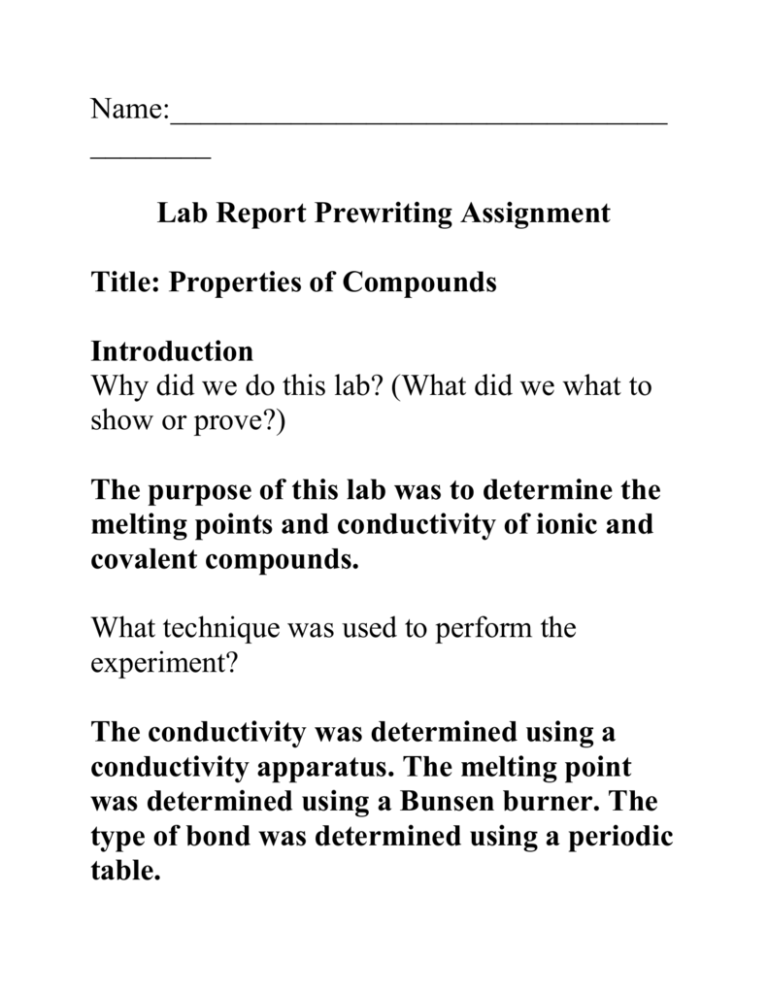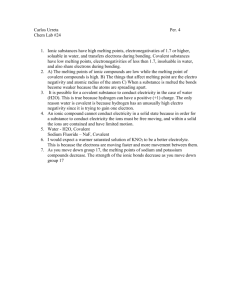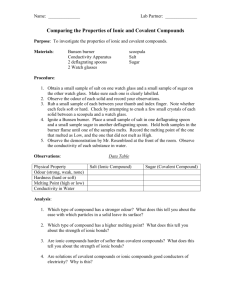File
advertisement

Name:_________________________________ ________ Lab Report Prewriting Assignment Title: Properties of Compounds Introduction Why did we do this lab? (What did we what to show or prove?) The purpose of this lab was to determine the melting points and conductivity of ionic and covalent compounds. What technique was used to perform the experiment? The conductivity was determined using a conductivity apparatus. The melting point was determined using a Bunsen burner. The type of bond was determined using a periodic table. What do we need to know about in order to understand this lab? To understand this lab we need to know about ionic and covalent bonds, electrolytes, melting point and the organization of the periodic table according to element classes. Hypothesis What do you think will happen? I think the covalent compounds will have similar conductivity and melting points. I also believe the ionic compounds will have similar conductivity and melting points, though they will be different than the covalent compounds. Procedure Stepwise directions (Past tense with no personal pronouns) At station 1 there were eight Dixie cups, each containing a solution of one of the compounds to be tested. Each solution was tested for conductivity by placing the probe of the conductivity apparatus into the solution. If the solution was conductive the light bulb lit up. If the solution was not conductive, the light bulb did not light up. The results for each test were recorded into data table 1. After each test, the probe was cleaned by immersing it in a beaker of clean water. At station 2 a sample of each compound was placed in a separate test tube. The test tube was then held in the flame of a lit Bunsen burner. If the substance melted, the melting point was considered to be low. If the substance did not melt, the melting point was considered to be high. The data was recorded in data table 2. At station 3 each substance was identified as either ionic or covalent by determining what types of elements make up the compound. If the compound contains a metal, the compound was identified as ionic. If the compound was only made up of nonmetals it was identified as covalent. The results were recorded in data table 3. Results Titles and numbers of tables and figures to be included in your report Data table 1: Properties of Compounds Lab Data Summary Summarize overall results in sentence form In data table 1, the results from the melting point experiment, electrolyte lab and the bond identification station were recorded. Conclusion Describe the data collected C6H12O6, H2O, C12H22O11 and C6H10O5 were all identified as covalent compounds. Each had a low melting point and did not conduct electricity. NaOH, NaCl, NaHCO3 and CaCl2 were all identified as ionic compounds. Each had a high melting point and did conduct electricity. Explain what the data tells you (Does it support or refute your hypothesis) All of the compounds identified as covalent compounds had low melting points and did not conduct electricity when dissolved in water. I would predict most covalent compounds will share these same properties. All the compounds identified as ionic compounds had high melting points and did conduct electricity when dissolved in water. I would predict most ionic compounds will share these properties. What, if anything, went wrong in this experiment? How might you improve this experiment? The probe for the conductivity apparatus must be cleaned between each test. Using more compounds would give us more accurate data.






